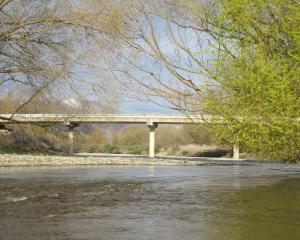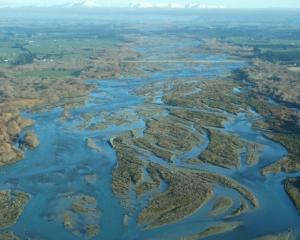
Environment Southland
Environment Southland is aiming for 10% improvement in its water quality in 10 years to deal with the cumulative effects on the region's water.
Environment Southland chairwoman Ali Timms said science had shown the region had ''seriously declining water quality''. The council had published four separate reports, which together made up the State of the Environment Report, Water 2010, which showed a general decline in water quality standards in lowland rivers and streams across the region, and worsening trends in some areas.
The Ministry for the Environment ranked Southland the worst of all regions for surface water nitrate-nitrite-nitrogen concentrations and sixth worst for dissolved reactive phosphorous. In 2011, the Office of the Auditor-general said Environment Southland was not doing enough to address declining water quality in the region, particularly the issues attributed to the effects of intensive farming. The council will also be expecting full compliance with all conditions on resource consents and permitted activities.
It was consulting stakeholder groups over five areas - hill-country development, nutrient levels, riparian management, winter grazing and run-off.
''It'll take a long time to fix and it may well get worse before it gets better.''
The region featured several slow-moving rivers servicing rich farmland but the bottom end of those catchments were not looking good.
As the region had experienced a huge increase in dairy conversions in the past 20 years - five years ago 100 conversions a year was normal - it needed to deal with the effects of intensive land use, Ms Timms said.
This year plan change 13 became effective requiring a consent for all new dairy conversions.
''It's about holding the line [on water quality].''
In the meantime, all existing dairy farms would progressively be required to meet tougher discharge rules as their resource consents came up for renewal, she said.
''It's a line in the same so there is no further decline.''
The impact of the changes would be different depending on where the planned conversion was and the area's soil types.
''Some may not need to do much more than they would have now ...other areas they might need to do a lot more.''
There were about 20 new conversions going through the process last year.
''There has been a lot of uncertainty and fear about it but what happens on land affects the water.''
People would need to do ''risk management'' assessments before they decided to convert, she said.
''If its cheap land there might be a reason for it; you might have to do more to mitigate any effects.''
Ms Timms described the council's draft long-term plan as a strategic response to the major issue of declining water quality, The most significant change is the council's decision to identify work specifically relating to the consequences of the expansion in dairy farming in Southland, and pay for those costs through the dairy differential rate on dairy farms, instead of spreading the cost among all ratepayers. That means the dairy differential rate will increase by $374,000 to $767,000 in the first year and rise again to a total of $1.467 million in 2013-14.
But it was not just about rural land users and their impacts, it was about the cumulative impact of everyone in Southland.
Rules backed up by good policy were needed, as without it best practice had no teeth, she said.
Winter grazing was an example of a practice that leaked nitrogen but with frozen, wet grounds for two or three months of the year, there was nowhere for it to go.
''We're asking people to make changes ...''
In the future, those changes could include farmers having to meet set nutrient levels.
Reaction to the changes had been interesting, with some seeing it as a reaction to the ''greenies'', but the rural sector, aware of the impacts of intensification, was more positive about it.
There was also the need for urban dischargers, such as district councils, to make more of an effort to meet discharge levels.
''Everybody has to tidy up their act; it has to be one rule for all.''
Environment Canterbury
One of Canterbury's greatest challenges when dealing with water issues is having plenty of it, but in the ''wrong places at the wrong time'', Environment Canterbury's Peter Constantine says.
It had been a rocky road for the council dealing with water quality and quantity issues, leading to the development of the Canterbury Water Management Strategy, he said at a resource management conference last year. The strategy outlined 223 targets, including ecosystem health, irrigation and environmental limits.
From that collaborative process came the Land and Water Plan notified this year, which had about 90 policies.
Council consultant Ian Brown said at the conference the council was facing significant issues, with about 400,000ha irrigated but the potential for 800,000ha to be.
''We have no illusion of the difficulty of this challenge and new water is a significant component of meeting environmental standards.''
There would be a lot of ''crunchy issues'' and there would need to be changes to farming systems.
Mr Constantine said regionally it prioritised drinking and stock water, set a goal for farmers of good practice and showed ''limits mean limits''.
''It's complex... a difficult situation and very fluid.''
That meant, until 2017, existing activities were permitted. After 2017, all activities will have to meet good practice guidelines set out in a look-up table.
It required a paradigm shift which he believed was happening, as some farmers who had flatly said it could not be done were now agreeing something needed to be done, he said.
At a catchment level, communities had the opportunity to determine the outcomes they wanted through zone committees, which would recommend to the council the limits to be set.
Some of the challenges the region faced were due to the Government, which on one hand was looking at Canterbury to provide a huge amount of economic growth, while on the other was demanding limits be set for water quality and quantity.
The proposals were not just targeted at rural discharges but urban, too. The Christchurch council reportedly asking for urban rivers to be removed from the plan, he said.
''If we remove those we lose everything we've just managed to gain with the rural sector, although the cost to the urban community will be more long-term.''
It meant farmers needed to start monitoring water on their properties. The council would leave them to manage the situation but they would have to meet limits.
Otago Regional Council
The Otago Regional Council was changing only a portion of its regional water plan, as the ''guts of it'' was working shown by the region's mostly ''pristine'' water, council land resources manager Susie McKeague said.
''It's important to us that it stays like that.''
Discussion with the region's communities showed everyone valued their rivers, streams and lakes and all wanted them to be swimmable, clear and in good health.
Last March the council notified its plan change after two years of discussion with the community.
The decision was that all water leaving the farm should be clear, odour-free and clear of grease or scum.
''The challenge is where those standards apply and when,'' she said at the resource management conference.
It proposed targets for surface water quality which were being considered by a hearing panel.
The region of most concern was South Otago and its degraded rivers, which were not meeting ecological or nitrogen standards.
''Interestingly, ammonia was improving, showing some improvement in effluent management.''
One of those rivers was the Pomahaka, which the council studied for two years and had AgResearch analyse its findings. It showed just where the problem lay - intensive farming.
The council had chosen not to go with consents, as while how to improve water quality was known, it did not know how to stop ''triple N'' problems yet, so writing a rule for such a consent condition would be difficult, she said.
It had proposed a prohibited activity rule, which gave farmers the opportunity to manage effluent well ''or be for the high jump''.
Under the plan, the standard was 30kg of nitrogen per year or in sensitive aquifer areas, 10kg.
Some areas, such as Wakatipu and Wanaka, had drinkable groundwater which meant they ''could not have intensive farming in those regions''.
Farmers were being given five to seven years to make the changes, she said.
If they could not meet the standards there was an option to apply for consent, aimed at small pockets trying to achieve the limits.
''We do not want 3000 consents to farm.''
It was not an out clause for those who just did not want to meet the standards, she said.
The council would not be measuring water coming off farms or designing farm plans, but it would work alongside farmers and link in industry professionals to help them meet the standards.
''If it comes to our attention it's probably gross [pollution]. Farmers need to be doing it themselves.''
Otago Regional Council
Otago: 32,000sq km
• 409 dairy farms in Otago.
• 2% seriously non-compliant.
Plan change 6A (water quality)
Dairy farms permitted activity - no consent needed for conversion.
• Proposing effects-based system to tackle water quality.
• Nitrogen loading not to exceed 150kg per ha per year, to be reduced to 30kg.
Sensitive zone 10Kg per ha per year.
• Does not involve urban dischargers.
• Notified in March.
• Waiting for hearing decision.
Environment Canterbury
Canterbury 42,239sq km
• 977 dairy farms.
• 30% non-compliance.
Land and Water Regional Plan
Based on Canterbury Water Management Strategy.
• Tackling quality and quantity together.
• Collaborative approach.
• Catchment-based.
• Zone committees to come up with limits.
• In holding position until 2017.
• Post-2017, all activities to be based on good practice.
• Notified in August.
• First stage of plan hearing held, starts again this month.
Environment Southland
Southland: 34,000sq km
• About 1686 dairy farms in Southland.
• 15% significant non-compliance.
Water and Land 2020
Consent for all new dairy conversions and consent for wintering stock:
Requires farm management plan.
Dairy farmers to pay for work related to the industry.
Charges dairy farms a ''differential'' rate which is to double.
• Maximum nitrogen loading 150kg ha per year.
• To involve urban dischargers as well.
• Still a work in progress.





